Last quarter, I got this text out of the blue:
Hey Dennis! It’s [consulting club president] from [a UCLA consulting club], hope you’re doing well. We were wondering if you were free sometime in the next two weeks to do a presentation for us about consulting case interviews. We’re a bit new to consulting, and would love to hear your tips and best practices.
(some other things …)
Thanks so much!
- Anonymous club president from an anonymous UCLA consulting club
Clearly, that text was paraphrased. I wrote it from memory since I only save my texts for 30 days, but that’s beside the point.
The point is that many people are interested in mastering the consulting case interview, but many people struggle with where to start. What even is a case interview? How do I practice? How can I improve?
Amazing questions, dear reader! This article will answer them all.
We’ll start off by defining some commonly used terms in the case interview world, answer some FAQs you may have right off the bat, and then we’ll jump into the step-by-step guide for nailing your case interview.
“Wow Dennis”, you’re thinking right now. “That sounds like a tremendous plan!”
Thanks! Let’s go 💪
Key Terms:
There’s a lot of lingo related to case interviewing, so it’s important you know the most common ones (they all kinda mean the same thing). Might as well start learning them now!
Case interview (the normal one)
Case (describes the same exact thing as a case interview, but in a shorter word)
Casing (the act of practicing a case)
Caser (one who cases)
Caseaholic (one who loves casing too much, I just made this one up but I definitely know some people who fit this description)
And let’s answer a couple big questions you may have right off the bat:
1. What even is a case interview?
Case interviews, or cases, are simplified business problems that you solve during an interview for a consulting club or company (and this guide is written for both club and company case interviews; club interviews are usually easier). These cases are ~15-30 minutes long and test your ability to think critically and solve problems quickly.
Case interviews feature a math section, and may require you to analyze and draw information from a graph. Crucially, the main thing in case interviews is not necessarily getting the right answers (there isn’t usually a “right” answer when solving a business problem, rather some answers are more right than others), but showing that you’re a quick thinker and a smart person. We’ll talk much more about what that looks like later.
Over the course of a case interview, the interviewer reveals more and more information that you continue to incorporate into your analysis, just like in real life. Some case interviews are “candidate-led”, meaning you as the candidate must ask for this additional information yourself. Other interviews are “interviewer-led”, meaning the interviewer themselves will share this additional information when needed.
Some simple examples of case interview questions are below. Notice that they’re all valid business questions someone has likely considered before:
An American water bottling company is considering expanding operations into Canada. Should they? What should they consider when doing so?
A shipping company specializing in container shipping is considering expanding into oil shipping. Should they?
How many hot dog stands are there in New York City? Do you recommend opening your own stand in NYC?
This article is a case interview guide. If you’re looking for a behavioral interview guide, check out this article here. When you have a final-round interview for a consulting company or club, there is usually a case and behavioral interview component, so make sure to practice both!
2. Is it anything like the real job at all?
Actually, yes!
When I was practicing for case interviews myself last year, I remember often wondering if I’d be doing anything similar on the job. It turns out that, yes, I did!
There are many overlaps between a case interview and a consulting project: in both, you’re faced with uncertainty and high pressure. In both, you’re presented with a business problem, and your task is to find the optimal solution. You need to know how to ask the right questions, analyze the right data, and iterate upon your findings from feedback shared by others (either your manager or interviewer). The interview tests if you can do all these things, and prepares you for the job ahead!
If you want to learn about how consulting works on the job, check out this article here.
3. Why are these case interviews so hard?
After a particularly challenging practice case or bombing a live interview, it’s very common to think, “[insert favorite expletive], why was that so hard?!” I know that I thought that MANY times during my practice!
During my summer internship at Boston Consulting Group (BCG), I learned why: hiring false positives is much worse than hiring false negatives.
In everyday English, that means that for top companies (MBB, FAANG, top startups, banks, etc.), the downside of hiring a bad candidate (a false positive) is much, much greater than the downside of not hiring a great candidate (a false negative).
The reasoning is simple: plenty of amazing candidates are applying for these extremely competitive roles, and you want to make sure that you’re only hiring great candidates. Bad candidates negatively affect not only themselves but also the entire broader team that they’re placed on. These “bad apples” are the false positives. Not good.
If you make your interviews extremely challenging, you’re guaranteed to filter out all of the bad applicants. In the process, unfortunately, you also filter out some great candidates (maybe they had a bad day, the interviewer wasn’t feeling good, you just got bad luck, etc.). This ultimately guarantees that nearly everyone that they hire is great.
The takeaway here is that if you bombed an interview or failed after lots of practice, it’s ok. There are plenty of jobs out there, and if you’re smart and hardworking, it will work out. I believe in you!
4. What makes someone a great caser?
This is a question I’ve given a lot of thought to, and I’ve realized that great casing comes down to two main things:
Excellent casing mechanics
Creativity in your problem-solving
In a case interview, you’re performing an intellectual dance with your interviewer: the interviewer gives you the prompt, you repeat it back, format your framework a certain way, ask questions a certain way, walk through your math a certain way, deliver your final framework a certain way. The collection of all these best practices and standards in your casing delivery is what I call “casing mechanics”.
These casing mechanics are learned solely from practice, and the only way to learn them is to sit down and do lots of practice cases. In a way, that’s comforting because if you practice enough, you’ll learn these mechanics well.
Creativity in your problem-solving is a different story. This creativity is often the “wow” factor in your interview and is what separates the great candidates from the amazing ones. It refers to how out-of-the-box your thinking is, and how well you can deliver your answers out loud. This creativity is MUCH harder to teach and requires a lot more cultivation over time to master.
My best advice for learning this creativity is to read the Morning Brew daily newsletter (it’s literally the only news I read) and incorporate some of the lessons, strategies, and news you learn there into your casing (always incorporate real-world events into your solutions when possible). I also recommend practicing casing with people that are better at casing than you, and seeing what kind of strategies they use (I did this all the time with my friend Tatiana)! The more you practice, the more of this creativity you’ll learn as well.
For most consulting companies and clubs, having excellent casing mechanics is enough for an offer. For the top consulting companies and clubs (notably the MBB firms of McKinsey, Bain, and BCG), you need to have both the mechanics and the creativity.
5. Why do you love ducks so much?
I really don’t know! I love birds of all kinds, but ducks, chickens, and geese are my favorites. I just get so happy when I see them! (I know this was off-topic, but I do really love ducks 🦆)
At this point, you’re probably like, “Ok Dennis, enough already! Can you please just get to the part where you teach me how to do a case already?”
Ok, ok, dear reader. Let’s get to it.
As I mentioned above, in a case interview, you’re performing an intellectual dance with your interviewer. This next section will be a practice example of doing an actual case, step-by-step. Consider me to be your intellectual dance instructor.
Our holy grail of practicing case interviews is the WORLD-FAMOUS, AMAZING, LEGENDARILY-AWESOME PETER K!!!
Peter K! Our hero! Yay!
Peter K is the nickname for the greatest casebook ever created (a casebook is a collection of practice case interviews). You can find it here.
Peter K has 24 different practice cases in it, with detailed explanations of how to solve each case, recommended approaches, and strategies for improvement. I exclusively practiced with cases from Peter K and by the end of my training, could confidently complete each case in the casebook. If you get to that level, you’re ready for your official case interviews!
For this walkthrough, we’re going to do my favorite beginner case, that of Getaway Airlines, starting on page 51. I’ll focus on the high-level strategies and what you should be thinking about throughout the case, and Peter K itself will give you the nitty-gritty details on each page. When practicing on your own, I recommend having someone else read you the interview questions, and you being ready to answer on the other side.
This casebook is similar to what your interviewer will have in front of them. Your practice buddy will have this case (or another case from Peter K) in front of them, and you’ll have your pen/paper (or iPad/Apple Pencil) ready to go. No calculator allowed, mental math time.
Remember, the case interview is an intellectual dance! 💃🏻
From a birds-eye view, here are the different parts of a case interview:
The interviewer reads you the prompt. You write down the important information, restate the prompt to make sure you got everything, and ask 2-3 clarifying questions.
You prepare and present your initial framework.
The interviewer asks several follow-up questions. These involve more strategic brainstorming, a math exercise, and potentially a graphical analysis.
You prepare and present your final recommendation, incorporating all the information you’ve gathered over the interview.
Let’s look at each step in more detail!
1. The interviewer reads you the prompt. You write down the important information, restate the prompt to make sure you got everything, and ask 2-3 clarifying questions.
Every case will start out with the interviewer reading you the prompt, which tells you the business problem you’re trying to solve. You write down the key information, paraphrase it back to the interviewer to make sure you didn’t miss anything, and ask a few clarifying questions to gain more context. The prompt is extremely important, as it reveals the main business problem we are trying to solve. Everything we do from here on out should relate back to this business problem, and the solution we’re finding!
Always ask 2-3 clarifying questions, but no more (not having clarifying questions looks really bad because it shows you’re not thinking about what other information you might need). My favorite framework for asking strong clarifying questions is OMGTime: Operations, Metrics, Geography, and Time.
Operations: Is the client a manufacturer? Supplier? Distributor? What exactly do they do?
Metrics: Are there any specific profitability, revenue, or cost goals we’re specifically trying to reach? What is the exact problem we’re trying to solve? (make sure you’re crystal clear on this!)
Geography: Where is our client located? Are they looking to expand to somewhere? Where to?
Time: What’s the timeline for this case? Is there a deadline for our goal?
These are great frames of reference for our clarifying questions. Let’s look at what Getaway Airlines’ prompt and questions are:

Notice, there is information there that is only provided upon request, meaning you must ask for it! If the information is necessary for a later part of the case and you forget to ask, it’ll usually be provided. However, it’s always best to ask for it yourself.
Sometimes when you ask a question, the interviewer will say, “We don’t have that information”, which is ok! The point is not necessarily getting an answer to each question you ask, but the fact that you’re asking good questions. Remember, the interviewer is trying to discover you’re a strong critical thinker.
In the Getaway Airlines case, the question we’re solving is how to reverse Getaway Airlines’ declining profitability. This is the main question of the interview, and what we always want to keep in mind. Everything we do from here on out should have Getaway Airlines’ profitability in mind.
2. You prepare and present your initial framework.
After you ask your clarifying questions, the next part of the case is your initial framework. Ask the interviewer for some time to brainstorm this — my recommendation is to say, “Can I please get a few moments to structure my thoughts?”. They’ll always say yes, and you’ll begin with your framework. Take two to two and a half minutes to brainstorm your framework, then present it to your interviewer.
The framework is your initial hypothesis on how to solve the business problem. You want to categorize your framework analysis into a few different groups, or “buckets”, and present them to your interviewer. You’ll then recommend a certain bucket you want to start with and move forward from there.
Ideally, you want three different buckets for this analysis. Strong buckets are usually “market”, “company”, and “financials”, though you always want to tailor them to your specific prompt. Generic buckets don’t look great, and creating good buckets is one of those things that takes practice and strong casing mechanics.
Remember, we’re looking at turning around declining profitability, so we want to keep that in mind when creating our buckets and sharing what we initially came up with. Here are the buckets for Getaway Airlines that Peter K came up with:
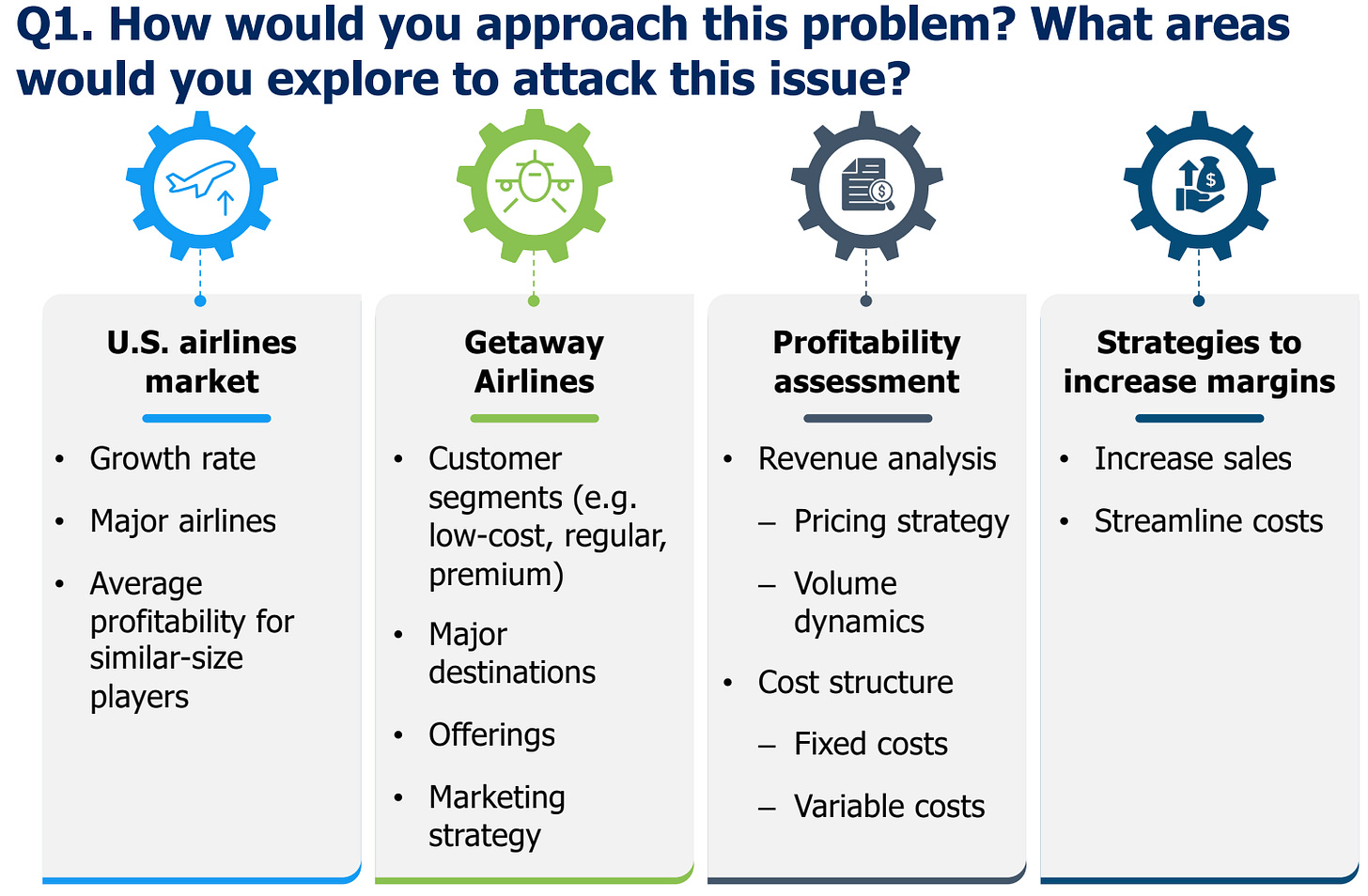
You can see the different areas (buckets) for analysis the casebook recommends exploring: the US airlines market, Getaway Airlines itself, its profitability, and margin strategies. Remember, we’re not actually doing this analysis quite yet, just sharing what we think are good areas to look further. This is what sharing your framework should look like (I’ll mention just the first three buckets here):
“After spending some time looking at Getaway Airlines, I’d like to focus on three key areas: the US airlines market, Getaway Airlines as a whole, and Getaway Airlines’ financials. (notice that here, I mentioned the three buckets before diving into each individually, make sure to do that yourself. Your interviewer wants to know what you’ll be talking about before you start talking about it)
Regarding the airlines market, I’d like to see if Getaway Airlines’ declining profitability is specific to them, or a broader trend we’re seeing across the entire market. Is the airlines market as a whole experiencing strong growth?
I’d also like to learn more about Getaway Airlines itself. What kind of customer are we tailored to? Are we a luxury, legacy, or a budget airline? What are our major destinations? What’s our marketing strategy? These will help us figure our where Getaway Airlines’ profit is declining from.
Lastly, I’d like to look at the specific financials of Getaway Airlines. Since we’re declining in our profitability, that means either our revenues are declining, our costs are increasing, or both. I’d like to do a revenue and cost analysis and see what’s happening there.
(If the interview is interviewer-led, end here. If the interview is candidate-led (meaning you need to drive the case forward), proceed with the statement below.)
With all that being said, if it’s alright with you, I’d like to start off with the market and look at the growth rate of other airlines.”
Notice that at the end, we drove the interview forward by suggesting what area we’d like to look into first. This suggestion will be wrong ~95% of the time, but that doesn’t matter! What matters is that we made the suggestion, not that it was right. Remember, it’s all an intellectual dance!
3. The interviewer asks several follow-up questions. These involve more strategic brainstorming, a math exercise, and potentially a graphical analysis.
After you present your framework, you’ll be asked several follow-up questions about the case. In each one, you’ll be presented with more information and asked to analyze it for the interviewer or come up with some more ideas. Always remember to consider the main prompt in your analysis. In our case, how does the additional information impact our view on Getaway Airlines’ declining profitability and our solution for fixing it?
For the Getaway Airlines case, the three follow-up questions we have are:
What revenue growth ideas can you suggest to double the market share in Getaway Airlines’ four major destinations (Las Vegas, Los Angeles, Portland, and Fort Myers)?
How would the client’s profits change if we succeed in doubling Getaway Airlines’ market shares in their four major destinations? (this is a math question with an attached graph)
How can Getaway Airlines boost its revenue apart from expanding its market share?
For each of these follow-up questions, ask for some time to brainstorm your responses before sharing them with the interviewer, just like we did with the initial framework (“Can I please get a few moments to brainstorm?”). In the follow-up questions, they may not always actually give you more time, so you may need to think on your feet a bit more.
When presented with a graph, you want to walk your interviewer through your thinking out loud. Here is the order of what you should look at when encountering a new graph:
The title (this tells you what you’re looking at)
The footnote (extremely important to look at, often provides crucial context)
The actual graph (the main chunk of information and what you analyze)
For your math questions, make sure to think out loud and walk through your thought process with the interviewer while initially doing the math. This will help the interviewer catch any mistakes you make before you get too far. If you make a mistake, that’s ok! It happens, and I’ve made plenty in interviews before. Making the mistakes out loud and quickly fixing them is much better than doing the entire problem wrong in silence.
Oh, wait! Did I happen to mention to DO ALL OF MATH OUT LOUD SO THAT THE INTERVIEWER CAN HEAR YOUR THOUGHT PROCESS IN REAL-TIME?! OMG PLEASE PLEASE PLEASE DO YOUR MATH OUT LOUD! There is nothing worse than a candidate doing all their math in silence and getting it all wrong because they made a simple mistake at the beginning.
For all the follow-up questions, you want to contextualize the findings immediately. As soon as you get more information, tie it back into the initial problem: how does this affect Getaway Airlines’ declining profitability? This is the mark of an excellent caser.
For Getaway Airlines, here are the relevant slides to the follow-up questions. Notice how they approach solving the problems, the buckets they make, and the steps for the math:
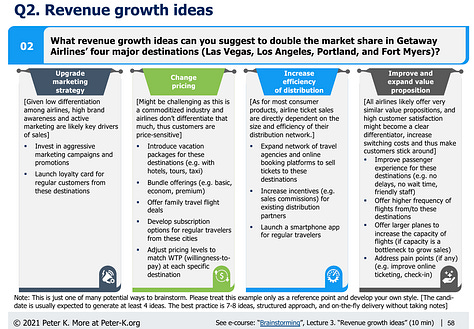
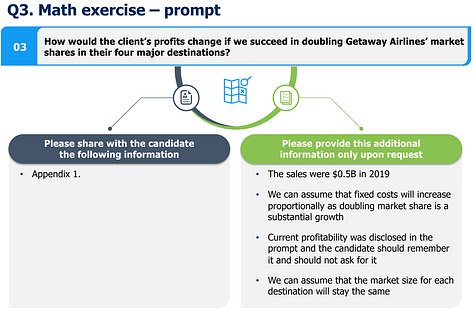
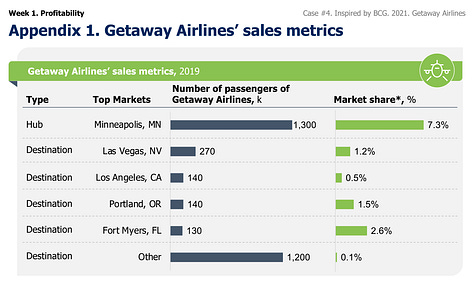
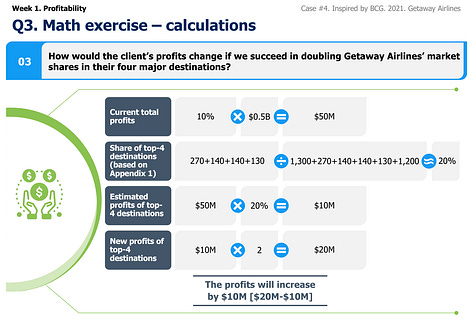
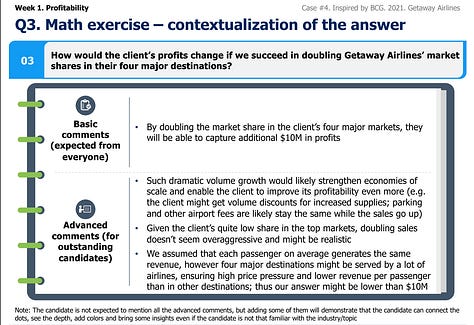
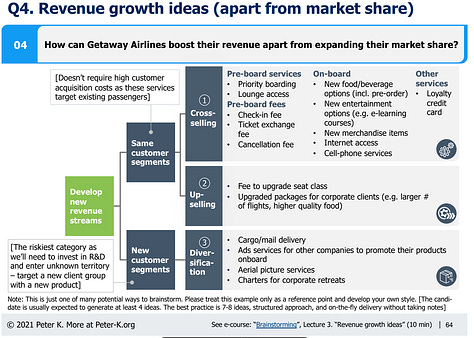
I’d also like to highlight the incredibly important footnotes on pages 58 and 64:
“This is just one of many potential ways to brainstorm. Please treat this example only as a reference point and develop your own style. [The candidate is usually expected to generate at least 4 ideas. The best practice is 7-8 ideas, structured approach, and on-the-fly delivery without taking notes]”
“The candidate is not expected to mention all the advanced comments, but adding some of them will demonstrate that the candidate can connect the dots, see the depth, add colors, and bring some insights even if the candidate is not that familiar with the industry/topic.”
You don’t need to nail every single point on these slides (that’s impossible), rather you need to have some of them and analyze them all well.
The last piece of advice I want to share about the math question is to avoid the resting bitch face (RBF). The RBF is an interesting phenomenon where candidates will be deeply focused on the math and while doing so, have an extremely unpleasant look on their faces. I recommend consciously practicing not looking pissed off (if you have an RBF, you know it lol, I did for a while during the math section). You don’t need to be cheesed up when doing mental math, but have at least a neutral expression on your face. 🙏
4. You prepare and present your final recommendation, incorporating all the information you’ve gathered over the interview.
Now that we’ve finished the follow-up questions, the last step in the case interview is to present your final recommendation to the interviewer. In this final recommendation, you’ll summarize everything you’ve covered so far and propose the next steps in the case. The interviewer will usually frame this question something along the lines of this:
“The client walks into the room (or you meet the client in the elevator) and they’re wondering how the project is going so far. What do you tell them?”
My favorite format for the final recommendation is RRRN: Recommendation, Reasoning, Risks, Next Steps, in that order. Each of these should be a sentence or two.
Recommendations: What you recommend to do (cut costs in something, increase marketing, whatever it may be, based on the follow-up questions and math you did before).
Reasoning: Why you recommend the above action, effectively summarizing your findings from the follow-up questions and math you did before.
Risks: Brainstorm a risk or two related to the recommendation.
Next Steps: 1-2 next steps, usually “conduct more research” of some kind or begin to implement some strategy you recommended.
Here’s the example for Getaway Airlines:
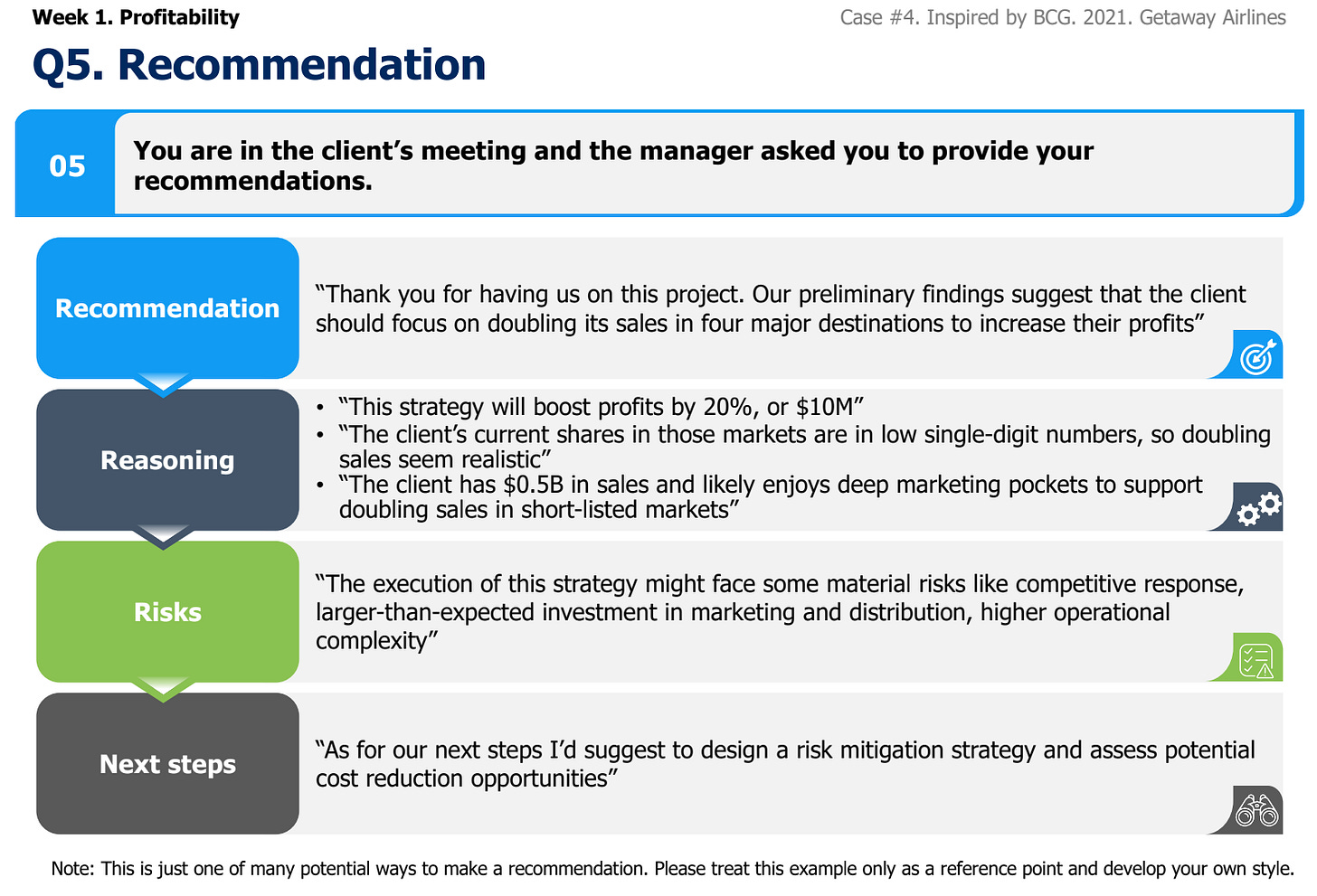
This final recommendation is the very last thing you’re telling to the interviewer, so can end the case with this banger (courtesy of my friend Tatiana):
… [Your final recomendation, following the RRRN structure] …
And with all that being said, it’s been such a pleasure working with you so far [client name], and [insert the consulting company or club name here] looks forward to working with you in the future! Thank you so much for your time.
(Example: “… such a pleasure working with Getaway Airlines so far, and BCG looks forward to continuing working with you in the future! …”)
Trust me, this leaves a smile on the interviewer’s face every time.
And congrats, you’ve finished your case interview! I’m so proud! At this point, the interviewer will congratulate you on what was no doubt an amazing interview and you’ll bask in the eternal glory of your success.
(hopefully)
You got this!
Some last things before we part:
A lot of you may be reading all this right now and feeling very overwhelmed and already behind. You might even be thinking, “Oh [insert favorite expletive here], I’m already so behind and I’m feeling stressed and this is not good oh nooooooo …”
This is NOT the case! (see what I did there 😏). I only recommend that you seriously start practicing your case interviews in the spring of your sophomore year before you start applying for consulting internships during the summer. Don’t burn yourself out too early!
Energy and enthusiasm matter a LOT in your case! Being enthusiastic and smiling a lot do wonders for your performance because you’re more confident and the interviewer is happier. Don’t forget to smile and be excited with the interviewer! Try to make the interview as FUN as possible.
A few weeks after doing a practice case, go back and re-do it to see how you’ve improved. When practicing, focus on improving on a specific part of the case. Maybe it’s the buckets you want to focus on, or using the RRRN strategy. Choose one thing, and make sure you nail it in that practice session.
I strongly recommend doing these practice cases live with another person, your “case buddy”. These can be friends, consulting club members, roommates, family, or even people you DM on LinkedIn! I almost exclusively practiced with my friend Tatiana.
I said it once, I’ll say it again. There is no substitute for learning casing mechanics other than practice. When I was preparing for case interviews, I did and gave a practice case interview three times a week for an entire summer with Tatiana. Needless to say, I got really good. A wise man creates his own luck! (if you’re interviewing for a consulting club, you can get by with one day of intense practice, they’re much more lenient than the consulting companies in their interviewing)
Contextualize your answers as soon as you get them, and refer to the real world when you can. Your business problem doesn’t exist in a bubble — tie it in to the real world if possible!
There are a ton more consulting interview resources in my Google Drive folder here, which I EXTREMELY highly recommend you check out! They include behavioral interview practice questions, more case books, and resume templates and guidelines.
If you’re looking for more math shortcuts and casing tips, check out the PDFs here and here.
In my experience, case interviews from Boston Consulting Group (BCG, where I interned last summer) always have a graph. Bain & Company interviews were much more math-heavy than the other companies I interviewed for. My best advice there is if you have an interview for a company coming up, tailor your practice to those company’s specific practice cases in Peter K.
Since case interviews are baby versions of what you’ll be doing in a consulting role, think about whether or not you actually like practicing for the case interviews. If you’re doing your practice cases and hating them, it’s very likely you similarly won’t enjoy working as a consultant, either.
There are LOTS of online resources for case interviews, and it can get quite overwhelming going through them all. Some good resources are here, here, here, and here. A great YouTube video is here.
Remember that text I got in the intro? I did the presentation for the club, and it went great! (and even inspired this article) Here’s the link to that original presentation.
And that’s all for now folks! I’ve been sitting in this Denny’s for 5 hours now, and they’re kicking me out.
Best,
Dennis :)
Thank you so so so much to Carly, Tatiana, Connor, Emily, Brooke, and Federico for reading the many drafts of this article and for all your amazing feedback. Y’all are the best!
Dennis’s Picks (things I’ve really enjoyed recently):
The book The Defining Decade. It’s hands down one of the most helpful self-improvement books I’ve ever read, and one I can’t recommend enough to anyone in college and/or their twenties. It shares amazing advice on starting your career, finding relationships and love, and good health practices.
The joke, “‘British people be like: “This website uses biscuits to improve user experience’”. I love British people! 🇬🇧
This quote about the importance of being flexible in your thinking: “To a hammer, everything looks like a nail.” 🔨




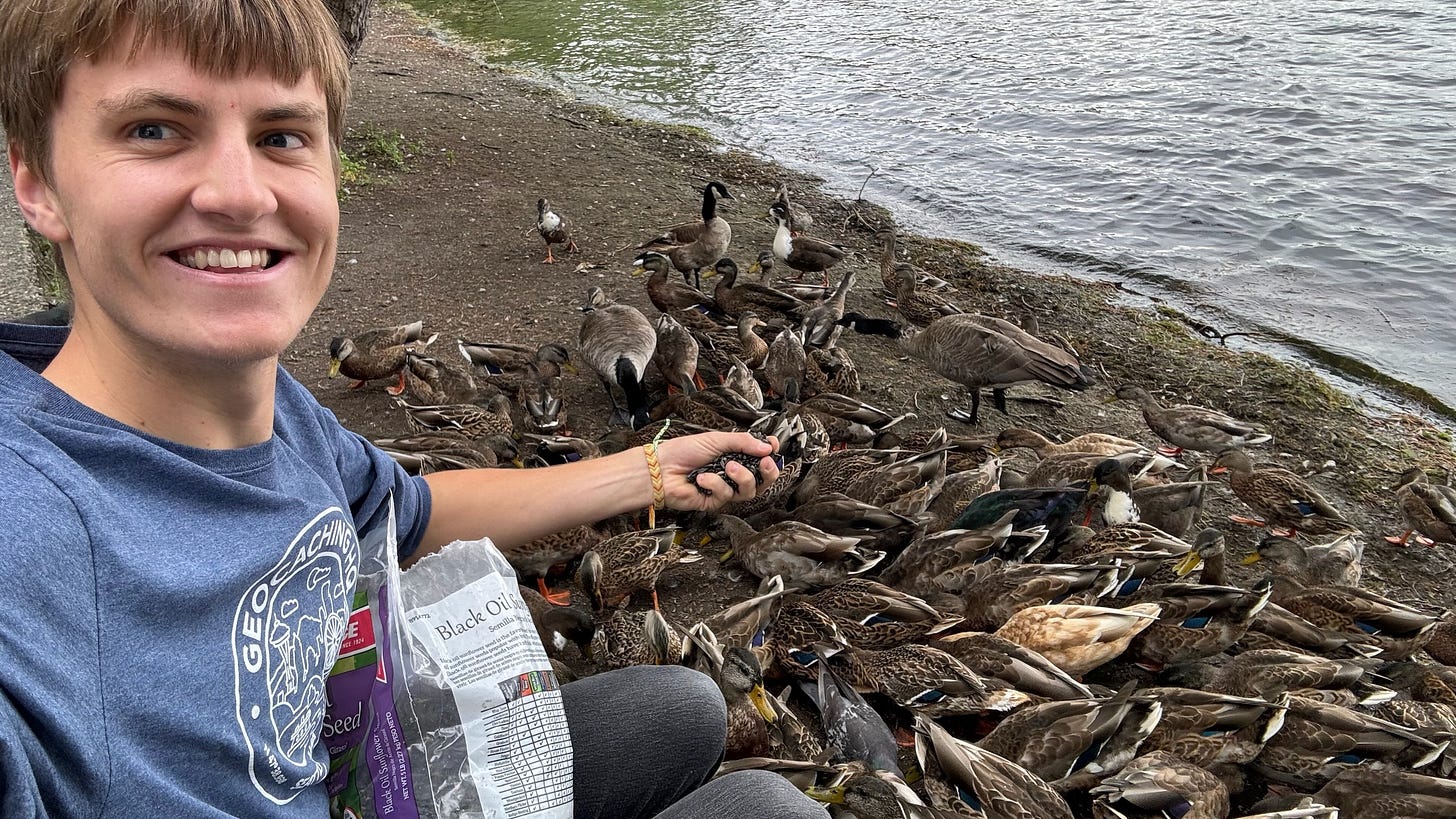

Sooooo helpful! Thank you for taking the time to write this article Dennis!